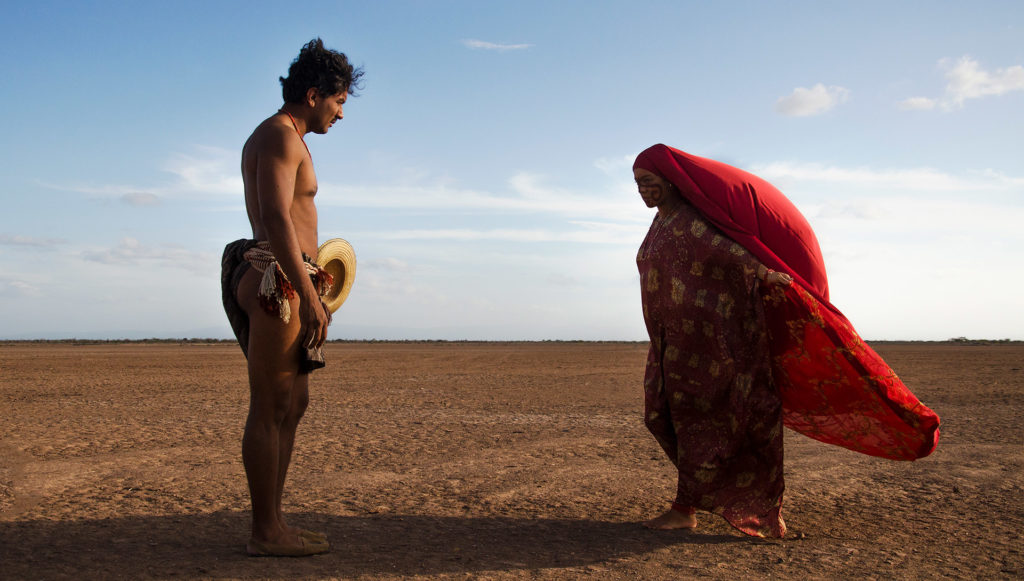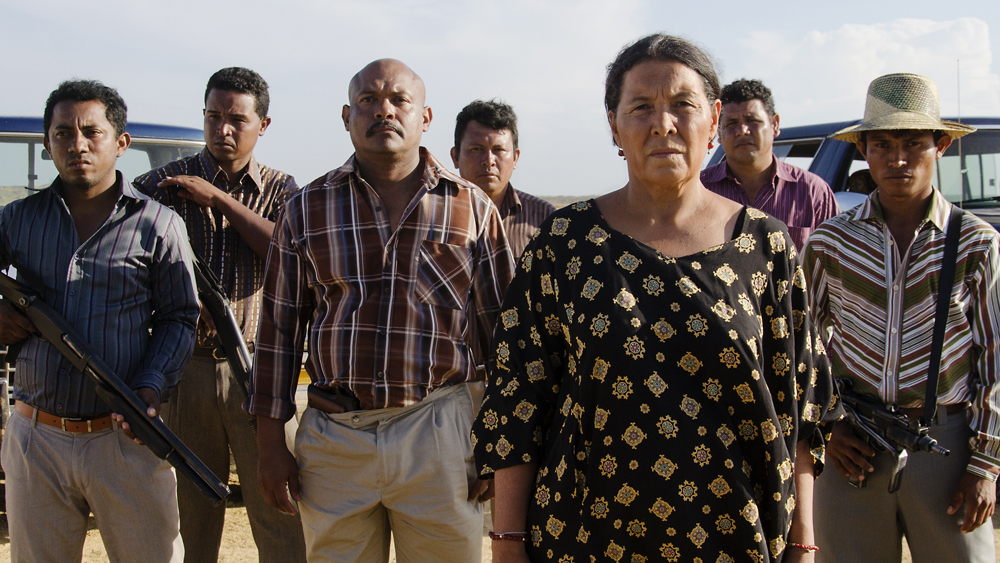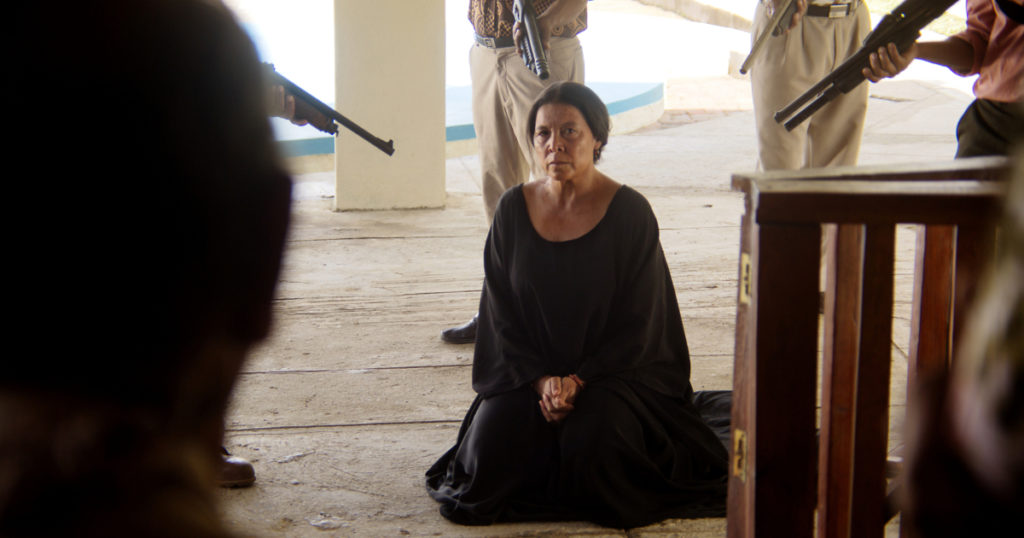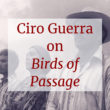Cristina Gallego discusses the genesis of the project, the use of bright colours in a gangster film, and much more. Read our interview with co-director Ciro Guerra here.

After the Oscar-nominated wonder of Embrace of the Serpent, Colombian filmmakers Cristina Gallego and Ciro Guerra return with Birds of Passage, another fable about the devastating effects of capitalism on a culture and its soul. Though similar in their themes and ideas, in every other respect, the two films couldn’t be more different: the black-and-white, quiet contemplation of the former stands in sharp contrast to the bright colours and violence of the latter.
Following the rise and fall of a drug family, Birds of Passage does not conceal its debt to other gangster films that came before it — Scarface and Casino, among others. But under its genre cloak, the film carries a devastating and brutal critique of the corrupting power of savage capitalism and imperialism. The people at the centre of the film, belonging to the Indigenous Wayuu tribe, do not even use money until they become involved in the drug trade. As they get richer and richer through trafficking, the cultural traditions and principles that they held onto as guidance for hundreds of years all fall to the wayside one by one.
Cristina Gallego served as producer on Ciro Guerra’s previous films, but the two share a directing credit here for the first time. We interviewed her about the genesis of the project, the idea of fate within the story of this family, and the Wayuu traditions which inform the film’s story and striking visual style.
Seventh Row (7R): What was the genesis of this project?
Cristina Gallego (CGa): We first had this idea about ten years ago. We were living in the region and began to hear stories about this period that was, for most of the people who lived there, like a golden age: huge sums of money suddenly arrived in the country, along with new goods and products, but also lots violence. It was something that I had seen when I was a child, too. I am the youngest in a big family, and I saw many of my brothers’ and sisters’ friends entering the drug trade.
So we started to hear these stories, but we also knew about the specific codes of behaviours of these people from the North of Colombia — not just the Wayuu people, but also the other inhabitants from that region. It was incredible how this moment in history, the beginning of marijuana and drug trafficking, had such a strong relation to the codes of behaviour of the people in that community. This immediately made us imagine a gangster movie, and we wanted to tell that story as soon as we heard it. We thought, “This is an amazing place to do a kind of Godfather!”

7R: The film reproduces typical tropes of the gangster film. But unlike other films of that genre, Birds of Passage doesn’t show the family’s rise to success as something positive or impressive. We’re not completely in favour of these characters succeeding.
CGa: We wanted to build this complex family without idealising them. We wanted to show that they were unable to escape from their destiny. Throughout cinema history, in the gangster war, we Colombians have always been represented as killers, drug dealers, or terrorists — all of these images associated with Scarface or Pablo Escobar. This imagery was something we were not comfortable with. But at the same time, we cannot say that we were the good guys; I think that we are complex like all human beings. We wanted to show this complexity in the characters within this family.
These are not events that happened only when the marijuana arrived. It could have been triggered by something completely unrelated to drugs. What made it happen was the arrival of savage capitalism. This is what destroys the family and their traditions in the film.
7R: The film is a critique of capitalism, as was Embrace of the Serpent, denouncing the way that capitalism can corrupt everything. But the visual styles of both films are very different. How did you develop the look of Birds of Passage?
CGa: Yes, it’s different, but I think it’s better suited to the space and the story we wanted to tell. Something very important for us is to, with each step, go to a totally different place than before. To start from another point, even if there are similarities: Birds of Passage takes place in the same place and region as one of our previous films, not Embrace of the Serpent but the one before that, The Wind Journeys. I think that each film has to follows its own path.
[click_to_tweet tweet=”‘These are not events that happened only when the marijuana arrived. It could have been triggered by something completely unrelated to drugs. What made it happen was the arrival of savage capitalism.’ –Cristina Gallego” quote=”‘These are not events that happened only when the marijuana arrived. It could have been triggered by something completely unrelated to drugs. What made it happen was the arrival of savage capitalism.’ –Cristina Gallego”]We wanted to use black and white in Embrace for certain reasons, and here we wanted to work with colour, because the Wayuu society has a very strong relationship to colours. They mean things. People use them in their clothes, and they use different ones for different moments in their lives. This is why you can also see the arc of the characters in Birds of Passage in the cinematography and in the set design — in the changes of clothes, furniture, makeup, and in the colours.

7R: Gangster movies are often full of moments of violence, and so is Birds of Passage. But here, those moments do not feel like genre tropes, and they’re not satisfying in that way — they just feel like horrible events that aren’t cathartic in any way. The violence feels uncalled for and truly upsetting.
CGa: It was very important for us was to portray the relations within the family. We wanted to tell the story from the perspective of the mother to make the audience feel the horror and pain of that violence. She’s the one who wants to keep the family and the tradition together. She sees that the family is the most important thing for her. Showing this story about a gangster war through the eyes of this woman makes you think and feel the way that we feel about the things that happened to our society. We are seeing how our society, traditions, culture, family are devastated, and we want to show that history from that point of view.
7R: There is a moment near the end of the film where there is a shift in the behaviour of the mother, where it seems that she wants to arrange the rituals to fit with her new desires. In Embrace, there is also this sense of people forgetting what rituals are for and why they should keep them.
CGa: I think that she knows everything, but she cannot avoid her destiny. She is the mother, but also the oracle. Even though she knows everything that is going to happen, she can’t do anything about it. She tries to warn people, telling them “don’t go there,” “don’t do that,” but she’s in a very macho society, where men are the ones taking the decisions. When the tragic destiny begins to unfold, she cannot understand how to better rule the family. She’s just doing the things that she thinks could be right, although they are wrong. I think she’s a very tragic character. She cannot avoid her destiny. Even if they take one decision or another, all things will collapse anyway, because their destiny is bigger than them.
Read our interview with Birds of Passage co-director Ciro Guerra >>

